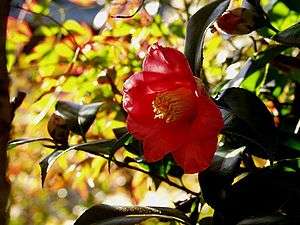| Camellia | |
|---|---|
 | |
| Genus: | Camellia |
| Family: | Theaceae |
| Type: | Trees and Shrubs |
| Transplant: | Transplants easily |
| Pollination: | Insects |
Camellia is a genus of flowering plants in the family Theaceae, native to eastern and southern Asia from the Himalaya east to Japan and Indonesia. There is some controversy over the number of existent species, with anything from 100–250 species being accepted. The genus was named by Linnaeus after Fr. Georg Joseph Kamel S.J., a Jesuit botanist.
Description
They are evergreen shrubs and small trees from 2–20 m tall. The leaves are alternately arranged, simple, thick, serrated, usually glossy, and 3–17 cm long. The flowers are large and conspicuous, 1–12 cm diameter, with (in natural conditions) 5–9 petals; colour varies from white to pink and red, and yellow in a few species. The fruit is a dry capsule subdivided into 1–5 compartments, each containing 1–8 seeds.
Growing conditions
The genus is generally adapted to acidic soils, and does not grow well on chalk or other calcium-rich soils. Most species also have a high rainfall requirement and will not tolerate drought.
Species
There are about 100–250 species, including:
- Camellia assimilis
- Camellia brevistyla
- Camellia caudata
- Camellia chekiangoleosa
- Camellia chrysantha – Golden
- Camellia
- Camellia connata
- Camellia crapnelliana
- Camellia cuspidata
- Camellia euphlebia
- Camellia euryoides
- Camellia forrestii
- Camellia fraterna
- Camellia furfuracea
- Camellia granthamiana
- Camellia grijsii
- Camellia hongkongensis - Hong Kong Camellia
- Camellia irrawadiensis
- Camellia japonica – Japanese Camellia
- Camellia kissii
- Camellia lutchuensis
- Camellia miyagii
- Camellia nitidissima
- Camellia nokoensis
- Camellia oleifera
- Camellia parviflora
- Camellia pitardii
- Camellia polyodonta
- Camellia reticulata
- Camellia rosiflora
- Camellia rusticana – Snow Camellia
- Camellia salicifolia
- Camellia saluenensis
- Camellia sasanqua – Christmas Camellia
- Camellia semiserrata
- Camellia sinensis – Tea
- Camellia taliensis
- Camellia transnokoensis
- Camellia tsaii
- Camellia vietnamensis
- Camellia yunnanensis
Uses
One species, Camellia sinensis (tea), is of major commercial importance. Tea oil is a sweet seasoning and cooking oil made by pressing the seeds of Camellia sinensis or Camellia oleifera.
Many other camellias are grown as ornamental plants for their flowers; about 3,000 cultivars and hybrids have been selected, many with double flowers, as in the gallery featured below. Camellia japonica (often simply called Camellia) is the most prominent species in cultivation, with over 2,000 named cultivars; next are C. reticulata, with over 400 named cultivars, and C. sasanqua, with over 300 named cultivars. Popular hybrids include C. × hiemalis (C. japonica × C. sasanqua) and C. × williamsii (C. japonica × C. salouenensis). They are highly valued in Japan and elsewhere for their very early flowering, often among the first flowers to appear in the late winter. Late frosts can damage the flowers.
Maintenance
Camellias have a slow growth rate. Typically they will grow about 30 centimetres a year until mature although this varies depending on variety and location.
Propagation
Harvesting
Pests and diseases
Leaf Spot
- Cercospora theae (in greenhouse conditions)
- Pestalosa guepini
- Phyllosticta camelliae
- Phyllosticta camelliaecola
- Sphaceloma
- Sporonema camelliae
Black Mold
- Meliola camelliae
Leaf Gall
- Exobasidium camelliae
Flower Blight
- Botrytis cinerea
- Sclerotinia camelliae
- Sclerotinia sclerotiorum
Canker
- Glomerella cingulata
Root Rot
- Phythopthora cinnamomi
Leaf Blight
- Cephaleuros virescens
Viruses: Variegation may be caused by a virus which vectors through grafting.
Bud drop: Caused by insufficient light, high temperatures before bloom, rootbinding, overwatering, sever freezing.
Chlorosis
Oedema-Caused by overwatering
Sunburn -Too much light
Salt injury
- Root Knot Nematode: Meliodgyne incognita
- Root Nematode: Hemicriconemoides gaddi
- Black Citrus Aphid: Toxoptera aurantii
- Melon Aphid: Aphis gossypii
- Green Peach Aphid: Myzus persicae
Scales
- Tea Scale: Fiorinia theae
- Florida Red Scale: Chrysomphalus aonidum
- Black Scale: Saissetia oleae
- California Red Scale: Aonidiella aurantii
- Camellia Scale: Lepidosaphes camelliae
- Chaff Scale: Parlatoria pergandii
- Cottony Taxus Scale: Pulvinaria floccifera
- Florida Wax Scale: Ceroplastes floridensis
- Glover Scale: Lepidosaphes gloveri
- Greedy Scale: Hemiberlesia rapax
- Hemispherical Scale: Saissetia coffae
- Latania Scale: Hemiberlesia lataniae
- Oleander Scale: Aspidiotus nerii
- Oystershell Scale: Lepidosaphes ulmi
- Olive Parlatoria Scale: Parlatoria pittospori
- Florida Red Scale: Chrysomphalus aonidum
- Euonymus Scale: Unaspis euonymi
- Greenhouse Whitefly: Trialeurodes vaporariorum
- Citrus Mealybug: Planococcus citri
- Longtailed Mealybug: Pseudococcus longispinus
- Black Vine Weevil: Otiorhynchus sulcatus
- Strawberry Root Weevil: Otiorhynchus ovatus
- Fuller Rose Beetle: Pantomorus cervinus
- Cranberry Rootworm: Rhabdopterus picipes
- Caterpillars
- Omnivorous Looper Caterpillars: Sabulodes aegrotata, Sabulodes caberata
- Orange Tortrix Caterpillar: Argyrotaenia citrana
- Fruittree Leafroller: Archips argyrospila
- Greenhouse Leaf Tier: Udea rubigalis
- Spotted Cutworm: Xestia spp.
- (see w:list of Lepidoptera which feed on Camellia).
- Camellia Bud Mite: Cosectatus camelliae
- Citrus Rust Mite: Phyllocoptruta oleivora
- Southern Red Mite: Oligonychus illicis
Gallery
 Double flowered Camellia
Double flowered Camellia- Camellia sasanqua
 Camellia japonica 'Pink Perfection'
Camellia japonica 'Pink Perfection' 19th century illustration
19th century illustration